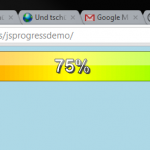How to pixelate images using Javascript
![]() Today there is again a bit of Javascript code. The exact topic is about how you can pixelate images via Javascript. This has both advantages and drawbacks, which I would like to briefly point out once below.
Today there is again a bit of Javascript code. The exact topic is about how you can pixelate images via Javascript. This has both advantages and drawbacks, which I would like to briefly point out once below.
Advantages:
Pixelation can be done dynamically (Manual effort in your graphics program falls away. Graphics must not be known beforehand.)
The computational power required is outsourced to the client side. In contrast to a server-side solutions (eg using PHP & Imagick), the computational load is distributed to the users. This helps to keep the server load low, if you have a lot of visitors.
Disadvantages:
The pixelation should be used rather as design or graphic effect, since the data is only sent not pixelated to the client. So if you really want to hide faces and picture information the pixelation still needs to be done before delivery to […]

 The .NET framework provides a large number of ways to encode HTML code and URLs. There exist, for example, Uri.EscapeDataString(), Uri.EscapeUriString(), System.Web.HttpUtility.UrlEncode(), System.Web.HttpUtility.UrlPathEncode(), System.Web.HttpUtility.HtmlEncode() or System.Web.HttpUtility.HtmlAttributeEncode().
The .NET framework provides a large number of ways to encode HTML code and URLs. There exist, for example, Uri.EscapeDataString(), Uri.EscapeUriString(), System.Web.HttpUtility.UrlEncode(), System.Web.HttpUtility.UrlPathEncode(), System.Web.HttpUtility.HtmlEncode() or System.Web.HttpUtility.HtmlAttributeEncode().
 It’s not often that I play games. And if I do, then my favorites are classic games. And yes, I still grow up with a Gameboy. With a large Gameboy. Since these are no longer available, I have already had one or two emulators in my hands. But what I’ve found now on the web, I’ve never seen before.
It’s not often that I play games. And if I do, then my favorites are classic games. And yes, I still grow up with a Gameboy. With a large Gameboy. Since these are no longer available, I have already had one or two emulators in my hands. But what I’ve found now on the web, I’ve never seen before.